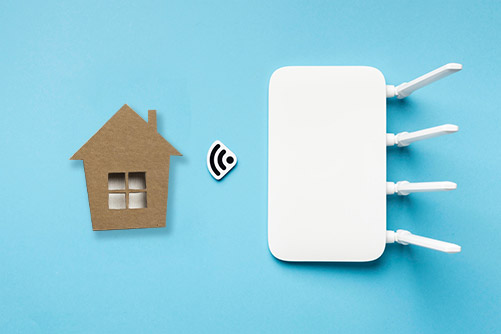All the broadband lines supplied by Connect-it are business services. This means that you share your connection with fewer users (the contention ratio). A typical contention ratio for a residential connection is 50:1, which means that you share the feed to your local cabinet with up to 49 other households. This explains why your speeds can drop dramatically at evenings and weekends, when others in the neighbourhood log on to play games and stream videos. In contrast, a typical business connection has a contention ratio of 20:1. Therefore, you are sharing with fewer other users, and those will be businesses rather than residential users. Your achieved speeds will still fluctuate according to the load put on the service by you and other connected users but the demand is often more predictable.

This is a standard broadband line that has download speeds of up to around 20Mbps and upload speeds of up to around 1.4Mbps. For applications such as VoIP telephony, this is enough for a small office, but it could struggle to support data usage and phones together.
There are occasions where one single ADSL line will not provide sufficient bandwidth, and faster alternatives are not yet available. One option here is bonded broadband. This is a process where up to four standard ADSL lines are linked on an aggregated connection that takes advantage of a higher transmission capacity. It does not mean that speeds of four times the single line can be achieved, but there is usually an improvement over the standard single ADSL capacity. Speeds and bandwidth will depend on various factors, including the locan infrastructure and the distance from the exchange. Internet speed (download)


Also known as “Superfast” broadband, this connection consists of a fibre-optic feed to the nearest roadside cabinet, then a copper connection to your premises. Speeds can vary, depending on the feed to the exchange, but can be up to 80Mbps download and up to 20Mbps on the upload. Unless your data usage is particularly heavy (for example streaming, or uploading large amounts of data), this kind of line will often be sufficient for a small or medium-sized business. We supply routers that are configured to prioritise the phone traffic so that this is protected from disruption.
FTTC is not available everywhere and even when it is an option, it is subject to fluctuations in speed, just like on a standard ADSL line. Costs are usually slightly higher than for an ADSL line.
FTTP is being provided as a replacement for FTTC broadband. This gives you a fibre-optic connection into the premises, rather than just to the nearest cabinet. It also gives higher performance, with download speeds of up to 330Mbps and upload speeds of up to 50Mbps possible.


This is the premium class of data provision, where you have an exclusive link direct from the exchange to your premises. It is the only service to guarantee a fixed speed, and the upload speed is usually the same as the download. Speeds can be set as low as 10Mbps down and up, but increasingly, our customers are choosing 100Mbps or even 1,000 Mbps (Gigabit) connections. This service is also usually supported by a service level agreement offering to fix faults within a set timeframe. For example the SLA for faults on a leased line from Connect-it is five hours.
The monthly cost of this line is generally significantly higher than for other options, but these costs are falling almost daily, as more businesses take up this service. For a business that depends on reliable connectivity for both data and phone traffic, this is the only serious contender on the table.
Telephony is changing. The analogue lines that we have all been using for many years are about to be phased out and replaced by digital connectivity. Although in some cases the physical connection might remain the same, its characteristics will be different.
In 2020 broadband and telephone providers will stop taking orders for standard phone lines and will only install either ADSL, FTTC or FTTP lines.
Phone services themselves will also change. You will no longer plug a phone into a socket on the wall, or require multiple lines terminating in an on-site switchboard or PBX. Instead, all telephony (both business and residential) will take place over broadband lines. The good news is that the technology is already in place to make this happen, so you can benefit today from a fully-hosted VoIP (Voice over Internet Protocol) phone system. Find out more about hosted telephony here [Hosted Phone Systems]. Connect-it specialises in installing and running hosted phone systems for small and medium-sized businesses, so you’re in good hands.

users/devices
5Mbps
1 or 2
Online browsing, research, email
25 Mbps
3 to 5
Large-file downloading, basic Wi-Fi, business communication
75 Mbps
5 to 10
Video streaming, frequent file sharing, numerous POS transactions
150 Mbps
10 to 15
Frequent cloud computing, video conferencing, data backups
250 Mbps
15 to 20
Server hosting, seamless streaming and conferencing
500 Mbps
20 to 30
Multiple-server hosting, constant cloud-based computing, heavy online backups
1 Gbps (1,000 Mbps)
30+
Extreme-speed operating for enterprise-ready offices with near-zero interruptions

